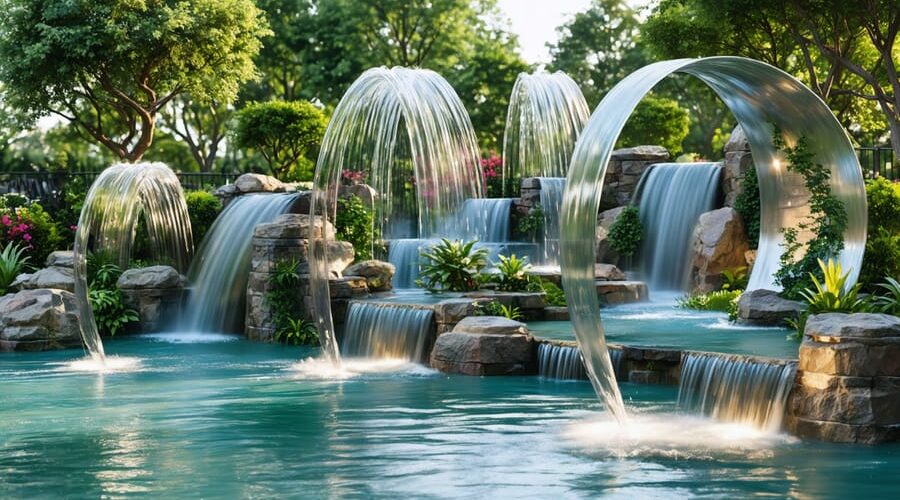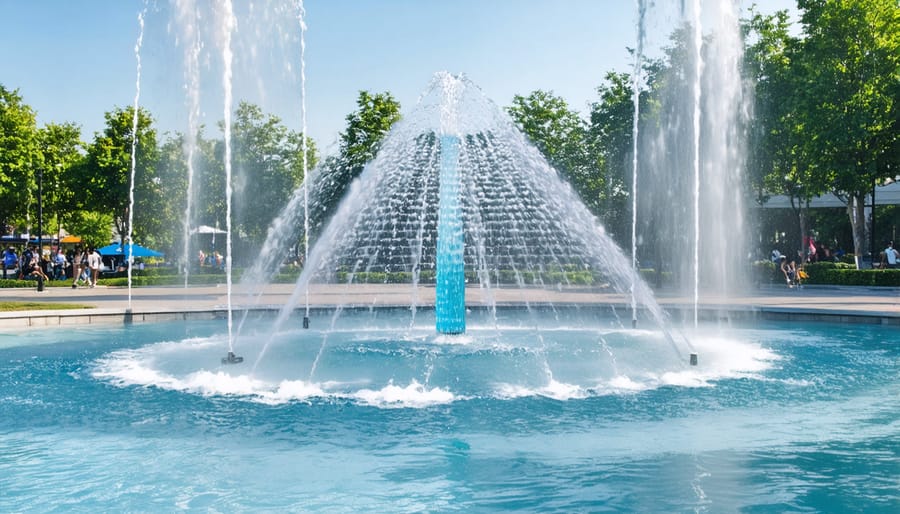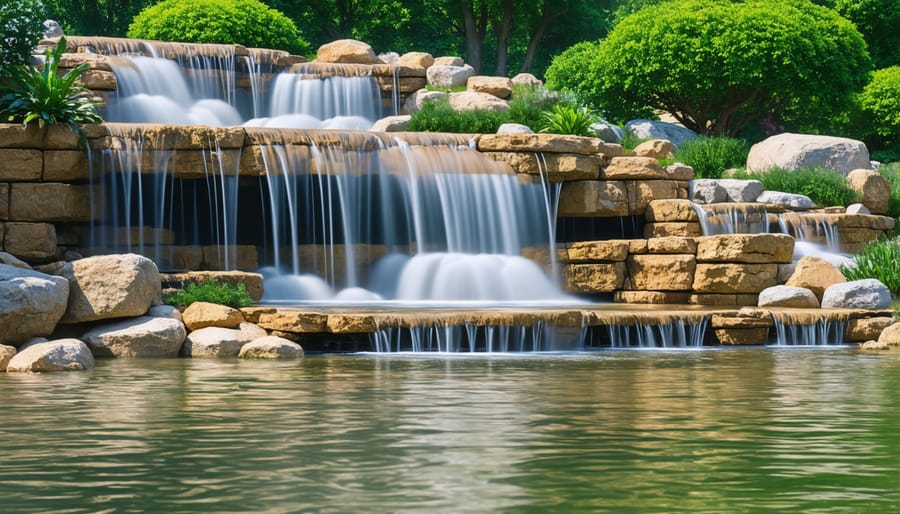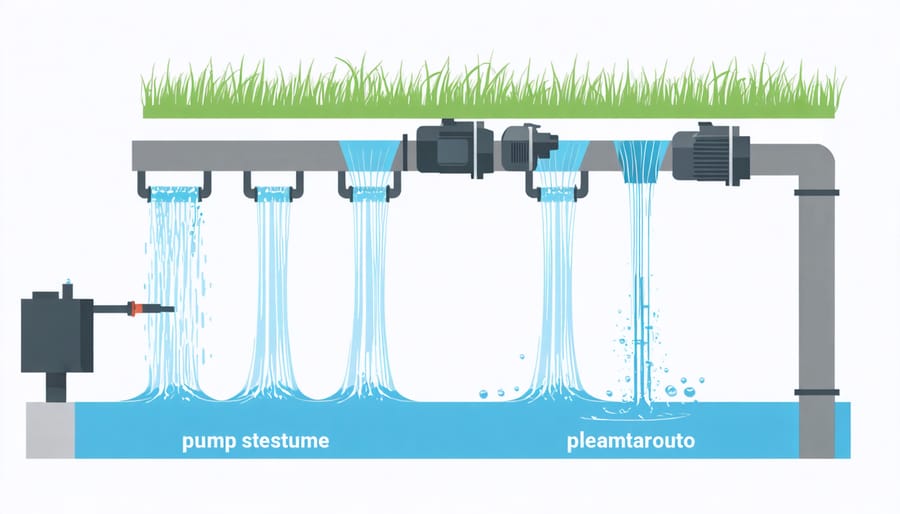
Transform Your Pond into a Dynamic Paradise with Kinetic Water Features
Transform your outdoor space with kinetic water features – dynamic, moving elements that bring life and energy to any garden or landscape. These mesmerizing show-stopping water features combine artistic design with the natural beauty of flowing water, creating focal points that captivate visitors and provide a sensory experience unlike any static decoration.
From spinning water wheels and rotating sculptures to pendulum-powered fountains, kinetic water features harness the power of movement to create ever-changing displays. Unlike traditional fountains, these interactive installations respond to wind, water pressure, or mechanical systems, producing unique patterns and sounds that evolve throughout the day.
Modern kinetic water features offer something for every space and budget – whether you’re looking to add a subtle accent to your meditation garden or create a bold statement piece for your front yard. The combination of engineering and artistry not only enhances your landscape’s visual appeal but also provides the soothing benefits of moving water, making them perfect for both residential and commercial settings.
Why Kinetic Features Bring Your Water Garden to Life
The Science Behind Moving Water
Moving water isn’t just beautiful to look at – it’s essential for maintaining a healthy aquatic environment. Understanding how water features work helps us appreciate their importance in pond ecosystems. When water moves, it naturally absorbs oxygen from the air, which is vital for fish, beneficial bacteria, and aquatic plants. This process, called aeration, helps prevent stagnant conditions where algae thrive and mosquitoes breed.
Think of moving water like nature’s cleaning service. As water flows, it helps distribute nutrients evenly throughout your pond, preventing dead zones where debris can accumulate. The movement also maintains consistent water temperature layers, which is especially important during hot summer months when oxygen levels can drop.
The gentle splashing of moving water also creates negative ions, similar to what you experience near a waterfall or ocean waves. These ions are known to improve air quality and create a more refreshing atmosphere around your water feature. Plus, the sound of flowing water naturally masks unwanted noise, creating a more peaceful garden environment.
Creating Atmosphere with Motion and Sound
Moving water has an almost magical ability to transform any space into a calming sanctuary. The gentle splash of a water feature creates a soothing white noise that naturally masks unwanted sounds like traffic or neighbor noise. This auditory element helps create a peaceful atmosphere that many find perfect for meditation or relaxation.
The visual movement of kinetic water features adds another dimension of tranquility. Watching water dance and flow has been shown to lower blood pressure and reduce stress levels. Whether it’s the hypnotic spinning of a water wheel or the graceful arc of a spillway, these moving elements draw the eye and help anchor us in the present moment.
In garden spaces, kinetic water features become natural focal points that invite contemplation. The combination of movement and sound attracts local wildlife, particularly birds, creating a more vibrant ecosystem. During evening hours, strategic lighting can transform these features into stunning nighttime displays, with water catching and reflecting light in mesmerizing patterns.
For those working from home, the consistent sound of moving water can improve focus and productivity by providing gentle background noise that doesn’t distract from tasks at hand.
Popular Types of Kinetic Water Features
Dancing Water Fountains
Dancing water fountains bring a magical dimension to any outdoor space, combining the soothing properties of water with captivating movement patterns. These dynamic features can help you create a peaceful garden oasis while adding a touch of playful energy.
The most popular styles include the classic bell fountain, which creates an elegant dome of water that catches the light beautifully. Multi-tier fountains offer cascading effects, with water tumbling from one level to the next in mesmerizing patterns. For a more contemporary look, laminar jets produce crystal-clear streams that arc gracefully through the air.
Sheet fountains create stunning water walls that can be illuminated for dramatic evening displays. Foam jets are perfect for adding whimsy, creating frothy white plumes that dance and sway in the breeze. For those seeking something truly special, programmable fountains can synchronize water movement with lights and music, though these are typically reserved for larger installations.
Each style creates its own unique atmosphere, from subtle and sophisticated to bold and dramatic, allowing you to match the fountain to your garden’s personality.

Cascading Waterfalls
Cascading waterfalls bring the soothing sights and sounds of nature right to your backyard. These stunning features can transform any space into a peaceful retreat, whether you’re working with a small garden or a sprawling landscape. The key to creating a natural-looking waterfall lies in the strategic placement of rocks and the careful manipulation of water flow.
When designing your cascading waterfall, start by planning multiple drops of varying heights. This creates a more organic appearance and produces those delightful bubbling sounds that make waterfalls so appealing. Choose rocks with weathered surfaces and irregular shapes to mimic nature, and consider incorporating small pools or catch basins between the drops to add visual interest.
Installation requires careful attention to the underlying structure. Begin with a sturdy foundation of compacted soil and use high-quality pond liner to prevent leaks. Position your pump at the lowest point and ensure proper plumbing to maintain consistent water flow. Hide tubing and mechanical elements beneath rocks and plants to maintain the natural aesthetic.
For added authenticity, surround your waterfall with moisture-loving plants and create small nooks for aquatic features. Remember to incorporate LED lighting to enjoy your cascade after dark.

Moving Stream Effects
Creating a natural-looking stream effect in your pond brings life and movement to your water feature. The key is strategically placing rocks and creating subtle variations in water flow. Start by installing a powerful pump at the stream’s source, ensuring it can handle your desired flow rate. Position larger rocks along the stream’s edges to direct water flow, and add smaller stones to create gentle rapids and mini waterfalls.
To enhance the stream’s movement, consider incorporating different levels and curves. These changes in elevation create natural-looking cascades and prevent water from moving too quickly. Adding aquatic plants along the banks helps soften edges and creates a more organic appearance. For added interest, install LED lights beneath the water surface to illuminate the moving stream at night.
Remember to maintain consistent water levels and regularly check your pump’s performance. A well-designed moving stream not only looks beautiful but also helps oxygenate your pond water and creates soothing sounds that mask unwanted noise. Experiment with different rock arrangements and flow rates until you achieve your desired effect.
Wind-Driven Features
Wind-driven water features bring a magical, ever-changing element to your garden by harnessing nature’s own energy. These eco-friendly additions create mesmerizing displays as breezes animate their components, causing water to dance, splash, and flow in unique patterns.
Popular wind-driven features include spinning water wheels, which turn gently in the breeze while trickling water along their paddles. Wind-activated spray nozzles create fascinating patterns as gusts of wind change their direction and intensity. For a more dramatic effect, wind-powered water sculptures use rotating arms or pivoting components to create dynamic water movements.
One of the best things about wind-driven features is their natural rhythm – they’re most active on breezy days when your garden could use extra cooling and ambiance. They’re also incredibly energy-efficient since they don’t require electricity to operate. Installation is typically straightforward, though you’ll want to position these features in areas that receive consistent airflow.
To maintain wind-driven features, regularly check for debris that might hinder movement and ensure all moving parts are properly lubricated. This will keep your feature running smoothly and ready to perform its water dance whenever the wind picks up.
Installation Tips for Success
Choosing the Right Location
Selecting the perfect spot for your kinetic water feature is crucial for both visual impact and practical functionality. Start by considering visibility – choose a location where you can enjoy the feature from key viewing areas like your patio, deck, or indoor living spaces. Natural gathering spots are ideal, as the moving water will create an inviting focal point for family and guests.
Wind exposure plays a vital role in how your kinetic feature performs. While a gentle breeze can enhance the movement, too much wind might disrupt the water flow or cause excessive splashing. Consider placing your feature near natural windbreaks like walls or hedges if your area experiences frequent strong winds.
Sun exposure is another important factor. Most kinetic water features look spectacular when sunlight catches the moving water, creating sparkles and reflections. However, if you’re including aquatic plants, they’ll need the right balance of sun and shade to thrive.
Practical considerations shouldn’t be overlooked. Ensure you have access to a power source for the pump, and consider how you’ll perform maintenance. Leave enough space around the feature for easy access. The ground should be level and stable – if necessary, create a solid foundation with pavers or a concrete pad.
Also think about your garden’s natural flow. Place your kinetic feature where it complements existing landscaping elements without overwhelming them. The sound of moving water should enhance your outdoor space, not compete with other features or create unwanted noise near quiet areas like bedrooms.
Power and Pump Requirements
Getting the right power and pump setup is crucial for your kinetic water feature to perform its mesmerizing dance. For most home installations, you’ll need a submersible pump rated between 250 and 1,500 gallons per hour (GPH), depending on your feature’s size and desired water movement. A good rule of thumb is to use 100 GPH for every inch of fountain width.
The pump’s height capacity, or “head height,” is just as important as its flow rate. If your feature stands 4 feet tall, you’ll need a pump that can lift water at least 5 feet to ensure proper flow. Remember to account for any horizontal distance the water needs to travel, as this affects the pump’s performance.
Most kinetic water features run on standard 120-volt power supplies, but you’ll want to use a GFCI-protected outlet for safety. Consider installing a timer to automate operation and save energy. For larger installations, you might need multiple pumps or a more powerful system rated at 220 volts.
Don’t forget about your power cord placement! Keep connections dry and protected from the elements, and consider burying the cord in a conduit for a cleaner look. Many DIY enthusiasts find that adding a variable speed controller gives them more flexibility in adjusting their feature’s movement patterns and water flow.

Maintenance Made Simple
Seasonal Care Guide
Keeping your kinetic water feature looking its best requires different care approaches throughout the year. In spring, remove any winter coverings and thoroughly clean the feature, checking for any damage from winter frost. Clean or replace filters and test the water pump to ensure smooth operation after winter dormancy.
Summer maintenance focuses on keeping water levels topped up due to increased evaporation. Remove debris like leaves and twigs weekly, and clean algae growth more frequently during warm months. Check moving parts monthly and lubricate if necessary to maintain fluid motion.
As autumn approaches, install protective netting to catch falling leaves before they can clog your feature. Regular cleaning becomes even more important during this season. Consider adding beneficial bacteria to help break down organic matter.
Winter care varies by climate. In mild areas, you can keep your feature running with reduced flow. In regions with freezing temperatures, drain the system completely, remove the pump, and store it indoors. Cover your feature with weatherproof material to protect it from ice damage and harsh winter conditions.
Remember to check all mechanical components quarterly, regardless of season, to ensure your kinetic water feature continues to perform beautifully year-round.
Troubleshooting Common Issues
Even the most beautiful kinetic water features can occasionally run into problems. Here’s how to solve common issues you might encounter:
If your feature stops moving or slows down, first check the water level – low water is often the culprit. Also, ensure your pump isn’t clogged with debris or calcium buildup. A quick cleaning usually solves this issue.
For squeaking or grinding sounds, apply a water-safe lubricant to moving parts. Remember to use products specifically designed for water features to avoid harming fish or plants.
Uneven movement often results from improper balance. Adjust the feature’s leveling by adding shims under the base. For spinning features, check that all arms or paddles are properly aligned and not bent.
If water splashes excessively, try reducing the pump’s flow rate or adjusting the feature’s position. Sometimes, adding splash guards or repositioning rocks can help direct water flow more effectively.
For features that freeze in winter, consider installing a small heater or removing moving parts during cold months to prevent damage.
Adding kinetic water features to your garden is more than just creating visual interest – it’s about crafting a dynamic, living space that engages all your senses. From the gentle splash of a floating sphere to the mesmerizing patterns of a water vortex, these features transform ordinary water gardens into extraordinary outdoor sanctuaries.
As we’ve explored, kinetic water features come in many forms, each offering unique benefits and opportunities for creativity. Whether you choose a simple spinning water wheel or an elaborate musical fountain, the key is selecting a feature that matches your space, budget, and maintenance capabilities.
Remember that successful installation depends on proper planning, regular maintenance, and understanding the basic principles of water flow and balance. Start small if you’re new to water gardening, and don’t be afraid to experiment as your confidence grows. The beauty of kinetic water features lies in their adaptability – you can always modify or expand your design as your skills develop.
Consider incorporating LED lighting or solar-powered elements to enhance your feature’s impact after dark. These additions can create stunning nighttime displays while remaining energy-efficient. Most importantly, take time to enjoy your creation. There’s something truly special about sitting beside a dynamic water feature, watching it move and listening to its soothing sounds.
Ready to get started? Your perfect kinetic water feature awaits, promising to bring life, movement, and joy to your outdoor space for years to come.
